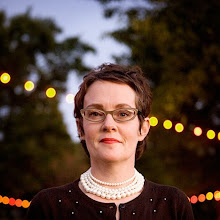
Green patch of my "place": table decoration from Laumeier's 2009 gala Out of the Park.
My dear pal Mary Louise Schumacher, art and architecture critic for the Milwaukee Journal Sentinel, has asked me to be here "foreign" correspondent for her own blog, Art City, link below.
http://www.jsonline.com/blogs/entertainment/artcity.html?tag=Marilu+Knode
(You may remember Mary Louise as my driving co-pilot in my move from Phoenix to St. Louis--she's the one who took the great picture of the burning truck.)
What she has done with her blog, Art City, is focus the energies and attention of the arts community in her region by becoming an expanded site for galleries, artists, dealers, collectors and their various audiences. The growth of the site, her addition of art maps, and features like "Pitch your Show", is an unparalled way for visual arts people to stay informed about the activities in the city. Art City is certainly a great model for other newspapers hoping to keep readership.
But Art City could only have happened on-line--no print publication could, or would, do all that for the arts, a notoriously bad sector for print advertising.
So we might well ask: what commitment do newspapers have to supporting the visual arts? They pay Mary Louise's salary--and that of the other arts writers at the paper who haven't taken a buy-out--THAT's what the Journal Sentinel is doing.
Sad that other newspapers don't gauge their arts writers' success by the same values they gauge a business writer: the interrogation of institutions and individuals, the highlighting of new trends, the health of the sector, the expansion of outlets and franchises, etc... Turns out arts writers do exactly what the business writers do (I mean that in a good way), only with more adjectives!












